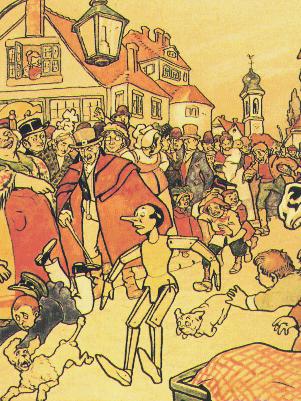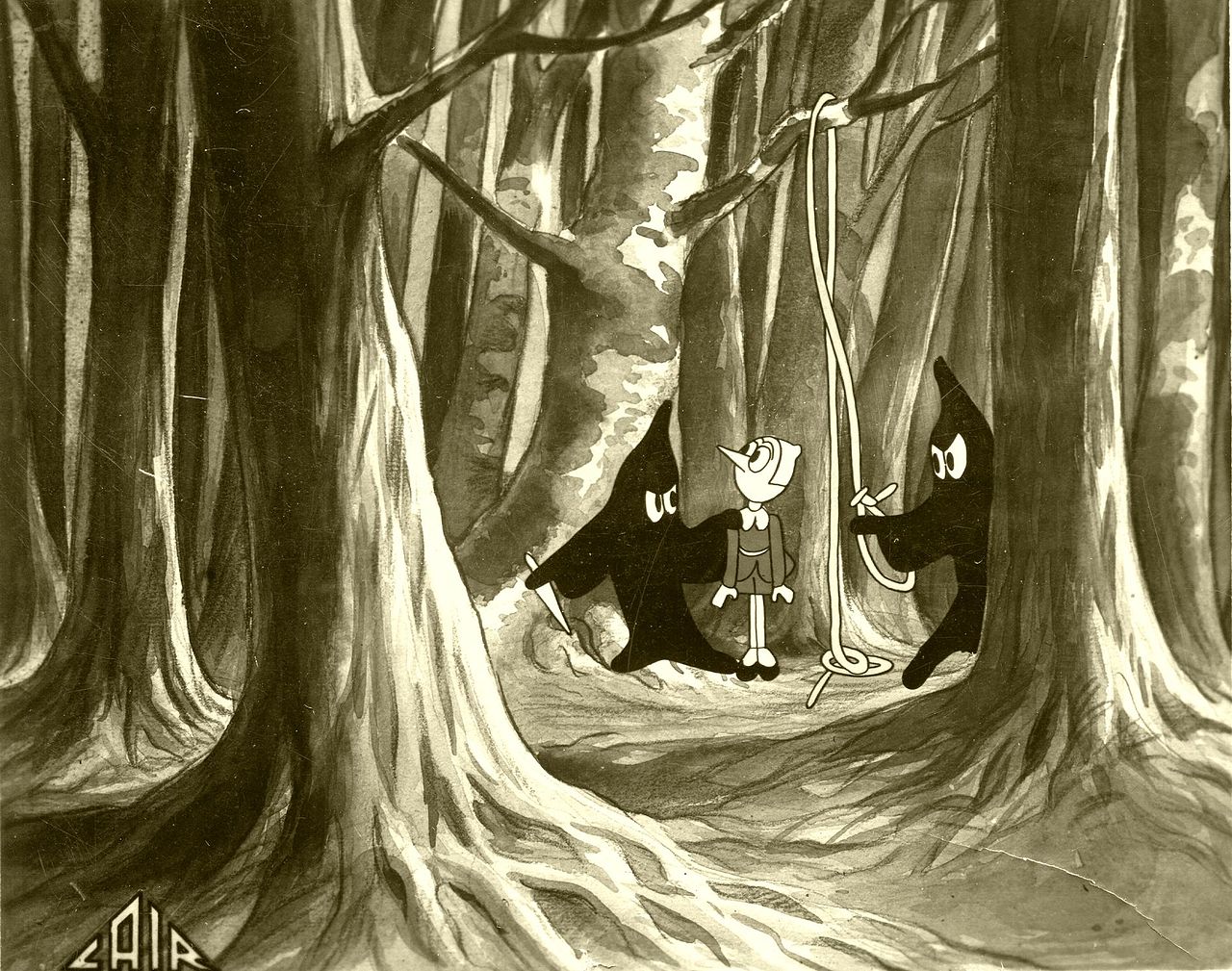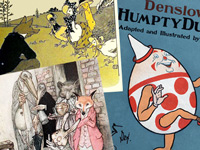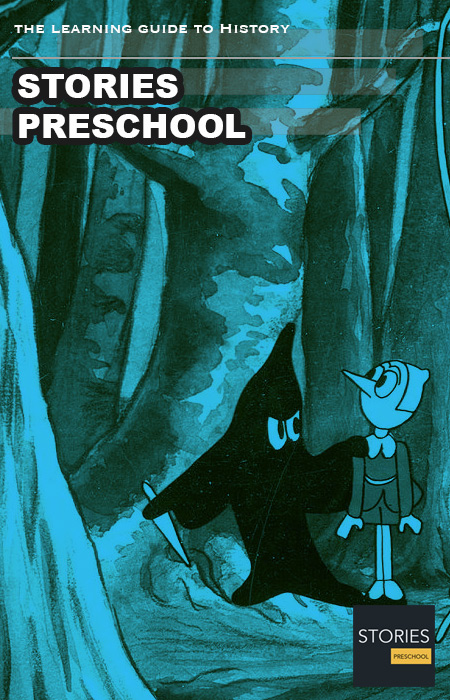The Adventures of Pinocchio

"The Adventures of Pinocchio" is a novel for children by Italian author Carlo Collodi, written in Pescia. The first half was originally a serial in 1881 and 1882, and then later completed as a book for children in February 1883. It is about the mischievous adventures of an animated marionette named Pinocchio and his father, a poor woodcarver named Geppetto. It is considered a canonical piece of children's literature and has inspired hundreds of new editions, stage plays, merchandising and movies, such as Walt Disney's iconic animated version and commonplace ideas such as a liar's long nose. According to extensive research done by the Fondazione Nazionale Carlo Collodi in late 1990s and based on UNESCO sources, it has been adapted in over 240 languages worldwide. That makes it among the most translated and widely read books ever written.
History
The Adventures of Pinocchio is a story about an animated puppet, boys who turn into donkeys and other fairy tale devices. The setting of the story is the Tuscan area of Italy. It was a unique literary marriage of genres for its time. The story's Italian language is peppered with Florentine dialect features, such as the protagonist's Florentine name.
In the 1850s, Collodi began to have a variety of both fiction and non-fiction books published. Once, he translated some French fairy-tales so well that he was asked whether he would like to write some of his own. In 1881, he sent a short episode in the life of a wooden puppet to a friend who edited a newspaper in Rome, wondering whether the editor would be interested in publishing this "bit of foolishness" in his children's section. The editor did, and the children loved it. The Adventures of Pinocchio were serialized in the paper in 1881–2, and then published in 1883 with huge success.
In the original, serialized version, Pinocchio dies a gruesome death: hanged for his innumerable faults, at the end of Chapter 15. At the request of his editor, Collodi added chapters 16–36, in which the Fairy with Turquoise Hair (or "Blue Fairy", as the Disney version names her) rescues Pinocchio and eventually transforms him into a real boy, when he acquires a deeper understanding of himself, making the story more suitable for children. In the second half of the book, the maternal figure of the Blue-haired Fairy is the dominant character, versus the paternal figure of Geppetto in the first part.
Children's literature was a new idea in Collodi's time, an innovation in the 19th century. Thus in content and style it was new and modern, opening the way to many writers of the following century.

The Adventures of Pinocchio (Italian: Le avventure di Pinocchio) was an Italian animated film directed by Raoul Verdini and Umberto Spano

The Adventures of Pinocchio (Italian: Le avventure di Pinocchio) was an Italian animated film directed by Raoul Verdini and Umberto Spano
( Click image to enlarge)
Plot
A carpenter finds a talking piece of wood and gives it to his poor neighbor, Geppetto, who carves the block into a marionette and names him Pinocchio. Pinocchio runs away as soon as he learns to walk. The marionette is caught by a Carabiniere, who assumes Pinocchio has been mistreated and imprisons Geppetto. Pinocchio goes back to Geppetto's house where he accidentally kills a talking cricket who had warned Pinocchio of the perils of disobedience and hedonism. That evening, Pinocchio falls asleep with his feet on the stove, and wakes to find that they have burned off. Geppetto is released from prison and makes Pinocchio a new pair of feet. In gratitude, Pinocchio promises to attend school, and Geppetto sells his only coat to buy him a school book.
On his way to school the next morning, Pinocchio encounters the Great Marionette Theatre, and he sells his school book in order to buy a ticket for the show. The marionettes on stage recognize him in the audience and call out to him, angering the puppet master Mangiafuoco. The puppet master initially decides to use Pinocchio as firewood but ultimately releases him and gives him five gold pieces to give to Geppetto.
As Pinocchio travels home to give the coins to his father, he meets a fox and a cat. The Cat pretends to be blind, and the Fox pretends to be lame. A white blackbird tries to warn Pinocchio of their lies, but the blackbird is eaten by the Cat, at which point the Fox states that the blackbird talked too much and had to be silenced. The two animals convince Pinocchio that if he plants his coins in the Field of Miracles outside the city of Catchfools, they will grow into a tree with gold coins. On the way to the field, they stop at an inn, where the Fox and the Cat gorge themselves on food at Pinocchio's expense and ask to be awoken by midnight. Two hours before the set time, the pair abandon Pinocchio, leaving him to pay for the meal with one of his coins. They instruct the innkeeper to tell Pinocchio that they left after receiving a message stating that the Cat's eldest kitten had fallen ill and that they would meet Pinocchio at the Field of Miracles in the morning. They take off ahead of Pinocchio and disguise themselves as bandits while Pinocchio continues on toward Catchfools, despite warnings from the Ghost of the Talking Cricket that he had killed earlier. The disguised Fox and Cat ambush Pinocchio, but the puppet escapes to a white house after biting off the Cat's paw. Upon knocking on the door, Pinocchio is greeted by a young fairy with turquoise hair who says she is dead and waiting for a hearse. Unfortunately, while Pinocchio is speaking with the Fairy, the bandits catch him and hang him in a tree. After a while, the Fox and Cat get tired of waiting for the puppet to suffocate, and they leave.
The Fairy has Pinocchio rescued by summoning a falcon to get him down and having her poodle servant Medoro pick him up in her stagecoach. The Fairy calls in three famous doctors to tell her whether Pinocchio is dead. Two of them, an owl and a crow, are unsure of Pinocchio's status. The third doctor is the Ghost of the Talking Cricket, who says that the puppet is fine, but has been disobedient and hurt his father. The Fairy administers medicine to Pinocchio who consents to take it after four undertaker rabbits arrive to carry away his body. Recovered, Pinocchio lies to the Fairy when she asks what has happened to the gold coins, and his nose grows until it is so long that he cannot turn around in the room. The Fairy explains that Pinocchio's lies are making his nose grow and calls in a flock of woodpeckers to chisel it down to size. The Fairy sends for Geppetto to come and live with them in the forest cottage.
When Pinocchio heads out to meet his father, he once again encounters the Fox and the Cat, who are no longer wearing their disguises. When Pinocchio notices the Cat's missing paw with the right arm in a sling, the Fox claims that they had to sacrifice it to feed a hungry old wolf. They remind the puppet of the Field of Miracles, and finally, he agrees to go with them and plant his gold. After half a day's journey, they reach the city of Catchfools, where every animal in town has done something exceedingly foolish and now suffers as a result. While traversing through Catchfools with the Fox and the Cat, Pinocchio sees that the streets are filled with hairless dogs yawning from hunger, sheared sheep trembling with cold, combless chickens begging for a grain of wheat, large butterflies unable to use their wings because they sold all their lovely colors, tailless peacocks ashamed to show themselves, and bedraggled pheasants scuttling away hurriedly and grieving for their bright feathers of gold and silver lost to them forever. Out of those paupers and beggars, Pinocchio also sees that there are beautiful coaches containing a fox, a hawk, and a vulture. Upon reaching the Field of Miracles, Pinocchio buries his coins and then leaves for the twenty minutes that it will take for his gold to grow into gold coin trees. After Pinocchio leaves, the Fox and the Cat dig up the coins and run away.
Once Pinocchio returns, he finds no trees and no gold coins and learns of the Fox and the Cat's treachery from a parrot who mocks Pinocchio for falling for their tricks. Pinocchio rushes to the Catchfools courthouse where he reports the theft of the coins to a gorilla judge. Although he is moved by Pinocchio's plea, the judge sentences Pinocchio to four months in prison for the crime of foolishness, and Pinocchio is locked up by the Mastiff Carabiniere. Fortunately, all criminals are released early by the jailers when the unseen young Emperor of Catchfools declares a celebration following his army's victory over the town's enemies. Upon being released, Pinocchio leaves Catchfools.
Pinocchio then heads back to the Fairy's house in the forest, Pinocchio sneaks into a farmer's yard to steal some grapes. He is caught in a weasel trap where he encounters a glowworm. The farmer finds Pinocchio and ties him up in the doghouse of his late watch dog Melampo to guard the chicken coop. When Pinocchio foils the chicken-stealing weasels, the farmer frees the puppet as a reward. Pinocchio finally comes to where the cottage was, finds nothing but a gravestone, and believes that the Fairy has died of sorrow.
A friendly pigeon sees Pinocchio mourning the Fairy's death and offers to give him a ride to the seashore, where Geppetto is building a boat in which to search for Pinocchio. Pinocchio is washed ashore when he tries to swim to his father. Geppetto is then swallowed by The Terrible Dogfish. Pinocchio accepts a ride from a dolphin to the nearest island called the Island of Busy.
Upon arriving on the Island of Busy, Pinocchio can only get food in return for labor. After some encounters with a coal man and a bricklayer, Pinocchio finally offers to carry a lady's jug home in return for food and water. When they get to the lady's house, Pinocchio recognizes the lady as the Fairy, now miraculously old enough to be his mother. She says she will act as his mother, and Pinocchio will begin going to school. She hints that if Pinocchio does well in school and tries his hardest to be good for one whole year, then he will become a real boy. Pinocchio studies hard and rises to the top of his class, but this makes the other schoolboys jealous. The other boys trick Pinocchio into playing hookey by saying they saw a large sea monster at the beach, the same one that swallowed Geppetto. However, the boys were lying and a fight breaks out. One boy named Eugene is hit by Pinocchio's school book, though Pinocchio did not throw it. Pinocchio is accused of injuring Eugene by two Carabinieres, but the puppet escapes. During his escape, Pinocchio saves a drowning Mastiff named Alidoro, a police dog who was chasing him.
In exchange, Alidoro later saves Pinocchio from The Green Fisherman, who was going to eat the marionette, as Pinocchio returns home. After meeting the Snail that works for the Fairy, Pinocchio is given another chance by the Fairy.
Pinocchio does excellently in school and passes with high honors. The Fairy promises that Pinocchio will be a real boy the next day and says he should invite all his friends to a party. He goes to invite everyone, but he is sidetracked when he meets a boy nicknamed Candlewick who is about to go to a place called Toyland where everyone plays all day and never works. Pinocchio goes along with him when they are taken there by The Coachman, and they have a wonderful time for the next five months.
One morning in the fifth month, Pinocchio and Candlewick awake with donkeys' ears. A Dormouse tells Pinocchio that boys who do nothing but play and never work always turn into donkeys while they are in Toyland. Soon both Pinocchio and Candlewick are fully transformed, and Pinocchio is sold to a circus by The Coachman. He is trained by the ringmaster to do tricks until he falls and sprains his leg. The ringmaster then sells Pinocchio to a man who wants to skin him and make a drum. The man throws the donkey into the sea to drown him. But when the man goes to retrieve the corpse, all he finds is a living marionette. Pinocchio explains that the fish ate all the donkey skin off him, and he is now a puppet again.
Pinocchio dives back into the water and swims out to sea. When the Terrible Dogfish appears, Pinocchio swims from it at the advice of the Fairy in the form of a little blue-furred goat from atop a high rock. Pinocchio does his best to outswim the Dogfish but is swallowed by it. Inside the Dogfish, Pinocchio sees a light from far off and follows it. At the other end is Geppetto who has been living on a ship inside the Dogfish. Pinocchio and Geppetto manage to escape the monster and search for a place to stay.
Pinocchio and Geppetto pass two beggars: the Fox and the Cat. The Cat has really become blind, and the Fox has really become lame and is also thin, is almost hairless, and has chopped off his tail to sell for food. The Fox and the Cat plead for food or money, but Pinocchio rebuffs them and tells them that their misfortunes have served them right for their wickedness. Geppetto and Pinocchio arrive at a small house, which is home to the Ghost of the Talking Cricket. The Talking Cricket says they can stay and reveals that he got his house from a little goat with turquoise hair. Pinocchio gets a job doing work for a farmer named Giangio and recognizes the farmer's dying donkey as his friend Candlewick.
After long months of working for the farmer and supporting the ailing Geppetto, Pinocchio goes to town with the forty pennies he has saved to buy himself a new suit. He discovers that the Fairy is ill and needs money. Pinocchio instantly gives the Snail he met back on the Island of Busy all the money he has, promising that he will help his mother as much as he is helping his father. That night, he dreams that he is visited by the Fairy, who kisses him. When he wakes up, he is a real boy at last. His former puppet body lies lifeless on a chair. Furthermore, Pinocchio finds that the Fairy has left him a new suit, boots, and a bag in which he thinks are the forty pennies that he originally gave to her. Instead, the boy is shocked to find forty freshly-minted gold coins. Geppetto also returns to health and resumes woodcarving.
Characters
- Pinocchio - Pinocchio is a naughty, pine-wood marionette who gains wisdom through a series of misadventures which lead him to becoming a real human as reward for his good deeds.
- Mister Geppetto - Geppetto is an elderly, impoverished woodcarver and the creator (and thus father) of Pinocchio. He wears a yellow wig that looks like cornmeal mush (or polendina), and subsequently the children of the neighborhood (as well as some of the adults) call him "Polendina", which greatly annoys him. "Geppetto" is a nickname for Giuseppe.
- Mastro Antonio - Antonio is an elderly carpenter. He finds the log that eventually becomes Pinocchio, planning to make it into a table leg until it cries out "Please be careful!" The children call Antonio "Mastro Ciliegia (cherry)" because of his red nose.
- The Talking Cricket (il Grillo Parlante) - The Talking Cricket is a cricket whom Pinocchio kills after it tries to give him some advice. The Cricket comes back as a ghost to continue advising the puppet.
- Mangiafuoco - Mangiafuoco is the wealthy director of the Great Marionette Theater. He has red eyes and a black beard which reaches to the floor, and his mouth is "as wide as an oven [with] teeth like yellow fangs". Despite his appearances however, Mangiafuoco (which the story says is his given name) is not evil.
- Harlequin (Arlecchino), Punch (Pulcinella), and Signora Rosaura - Harlequin, Punch, and Signora Rosaura are marionettes at the theater who embrace Pinocchio as their brother.
- The Fox and the Cat (la Volpe e il Gatto) - Greedy animals pretending to be lame and blind respectively, the pair lead Pinocchio astray, rob him and eventually try to hang him.
- The Innkeeper (l'Oste) - An innkeeper who is in tricked by the Fox and the Cat where he unknowingly leads Pinocchio into an ambush.
- The Fairy with Turquoise Hair (la Fata dai capelli turchini) - The Blue-haired Fairy is the spirit of the forest who rescues Pinocchio and adopts him first as her brother, then as her son.
- The Falcon (il Falco) - A falcon who helps the Fairy with Turquoise Hair rescue Pinocchio from his hanging.
- Medoro - A poodle who is the stagecoach driver for the Fairy with Turquoise Hair. He is described as being dressed in court livery, a tricorn trimmed with gold lace was set at a rakish angle over a wig of white curls that dropped down to his waist, a jaunty coat of chocolate-colored velvet with diamond buttons and two huge pockets which were always filled with bones (dropped there at dinner by his loving mistress), breeches of crimson velvet, silk stockings, and low silver-buckled slippers completed his costume.
- The Owl (la Civetta) and the Crow (il Corvo) - Two famous doctors who diagnose Pinocchio alongside the Talking Cricket.
- The Parrot (il pappagallo) - A parrot who tells Pinocchio of the Fox and the Cat's trickery that they played on him outside of Catchfools and mocks him for being tricked by them.
- The Judge (il Giudice) - A gorilla venerable with age who works as a judge of Catchfools.
- The Serpent (il Serpente) - A large serpent with bright green skin, fiery eyes which glowed and burned, and a pointed tail that smoked and burned.
- The Farmer (il Contadino) - An unnamed farmer whose chickens are plagued by weasel attacks. He previously owned a watch dog named Melampo.
- The Glowworm (la Lucciola) - A glowworm that Pinocchio encounters in the farmer's grape field.
- The Terrible Dogfish (Il terribile Pesce-cane) - A mile-long, five-story-high fish. Pescecane, while literally meaning "dog fish", generally means "shark" in Italian.
- The Pigeon (il Colombo) - A pigeon who gives Pinocchio a ride to the seashore.
- The Dolphin (il Delfino) - A dolphin who gives Pinocchio a ride to Busy Bee Island.
- The Snail (la Lumaca) - A snail who works for the Fairy with Turquoise Hair. Pinocchio later gives all his money to the Snail.
- Alidoro (del can mastino) - The old mastiff of a carabineer.
- The Green Fisherman (Il Pescatore verde) - A green-skinned ogre who catches Pinocchio in his fishing net and attempts to eat him.
- Romeo - "Lampwick" or "Candlewick" (Lucignolo) - A tall, thin boy (like a wick) who is Pinocchio's best friend and a trouble-maker.
- The Little Man (l'Omino) - The owner of the Land of Toys.
- The Dormouse (la Ghiro) - A Dormouse who lives in the Land of Toys. He is the one who tells Pinocchio about the Land of Toys' magic.
- The Ringmaster (il Direttore) - The unnamed ringmaster of a circus.
- The Master (il compratore) - A man who wants to make Pinocchio's hide into a drum.
- The Tuna Fish (il Tonno) - A tuna fish as "large as a two-year-old horse" who has been swallowed by the Terrible Shark.
- Giangio - The farmer who buys Romeo as a donkey and who Pinocchio briefly works for. He is also called Farmer John in some versions.

Attilio Mussino (1878 - 1954) - 1911 edition of The Adventures of Pinocchio

Attilio Mussino (1878 - 1954) - 1911 edition of The Adventures of Pinocchio
( Click image to enlarge)
A fairy tale is a type of short story that typically features folkloric fantasy characters, such as dwarves, elves, fairies, giants, gnomes, goblins, mermaids, trolls, or witches, and usually magic or enchantments. Fairy tales may be distinguished from other folk narratives such as legends (which generally involve belief in the veracity of the events described) and explicitly moral tales, including beast fables. The term is mainly used for stories with origins in European tradition and, at least in recent centuries, mostly relates to children's literature.
Read More » List of Fairy tales »
RESOURCES
This article uses material from the Wikipedia articles "List of fairy tales", "Fairy tale" and "The Adventures of Pinocchio", which is released under the Creative Commons Attribution-Share-Alike License 3.0.
© Stories Preschool. All Rights Reserved.






